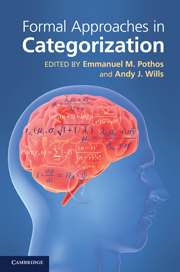Book contents
- Frontmatter
- Contents
- List of figures
- List of tables
- List of contributors
- 1 Introduction
- 2 The generalized context model: an exemplar model of classification
- 3 Prototype models of categorization: basic formulation, predictions, and limitations
- 4 COVIS
- 5 Semantics without categorization
- 6 Models of attentional learning
- 7 An elemental model of associative learning and memory
- 8 Nonparametric Bayesian models of categorization
- 9 The simplicity model of unsupervised categorization
- 10 Adaptive clustering models of categorization
- 11 Cobweb Models of Categorization and Probabilistic Concept Formation
- 12 The knowledge and resonance (KRES) model of category learning
- 13 The contribution (and drawbacks) of models to the study of concepts
- 14 Formal models of categorization: insights from cognitive neuroscience
- 15 Comments on models and categorization theories: the razor's edge
- Index
- References
9 - The simplicity model of unsupervised categorization
Published online by Cambridge University Press: 05 June 2012
- Frontmatter
- Contents
- List of figures
- List of tables
- List of contributors
- 1 Introduction
- 2 The generalized context model: an exemplar model of classification
- 3 Prototype models of categorization: basic formulation, predictions, and limitations
- 4 COVIS
- 5 Semantics without categorization
- 6 Models of attentional learning
- 7 An elemental model of associative learning and memory
- 8 Nonparametric Bayesian models of categorization
- 9 The simplicity model of unsupervised categorization
- 10 Adaptive clustering models of categorization
- 11 Cobweb Models of Categorization and Probabilistic Concept Formation
- 12 The knowledge and resonance (KRES) model of category learning
- 13 The contribution (and drawbacks) of models to the study of concepts
- 14 Formal models of categorization: insights from cognitive neuroscience
- 15 Comments on models and categorization theories: the razor's edge
- Index
- References
Summary
Summary
The main objective of the simplicity model of unsupervised categorization is to predict the relative intuitiveness of different classifications of items, based on their similarity. The model derives from the minimum description length framework, which is an algorithmic formalization of Ockham's razor. It generally prefers classifications which maximize within- category similarity, while minimizing between-category similarity.
Description of the model
The simplicity model of categorization can be viewed as one route to the formalization of Rosch and Mervis's (1975) proposal concerning the nature of ‘basic level’ categories, that is, the categories with which we prefer to classify objects (as opposed to corresponding superordinate or subordinate categories). According to Rosch and Mervis, basic level categories are those that maximize within-category similarity and minimize between-category similarity. Pothos and Chater (2002) examined whether this proposal may be suitable for predicting category preference generally, within a computational framework based on the simplicity principle.
The application of the simplicity principle in psychology has its origins in theories of perception (e.g., Hochberg & McAlister, 1953; Mach, 1959/1906). Informally, the simplicity principle states that simple explanations should be preferred – here ‘explanation’ refers to a pattern or structure in the data. The intuition is that the degree to which a pattern is suggested by the data can be quantified by assessing how briefly the data can be encoded, using that pattern.
Information
- Type
- Chapter
- Information
- Formal Approaches in Categorization , pp. 199 - 219Publisher: Cambridge University PressPrint publication year: 2011
